What Is Project Implementation?
Project implementation, or project execution, is the process of completing tasks to deliver a project successfully. These tasks are initially described in the project plan, a comprehensive document that covers all areas of project management. However, a secondary action plan, known as an implementation plan, should be created to help team members and project managers better execute and track the project.
What Is an Implementation Plan?
An implementation plan is a document that describes the necessary steps for the execution of a project. Implementation plans break down the project implementation process by defining the timeline, the teams and the resources that’ll be needed. It also outlines how the project will be executed, monitored and completed. An implementation is a roadmap for the project team, showing the necessary steps to reach the goals and deliverables within a specified timeframe and budget.
An implementation plan is commonly made of up certain key components. It opens with a brief project overview, then goes into the goals and objectives of the project. There is a detailed breakdown of the project tasks, and an outline of its timeline and resource allocation. The roles and responsibilities of the team members, stakeholders and external partners are defined. The project implementation also includes a risk management plan, how the project will be monitored and evaluated, a communication plan and a budget.
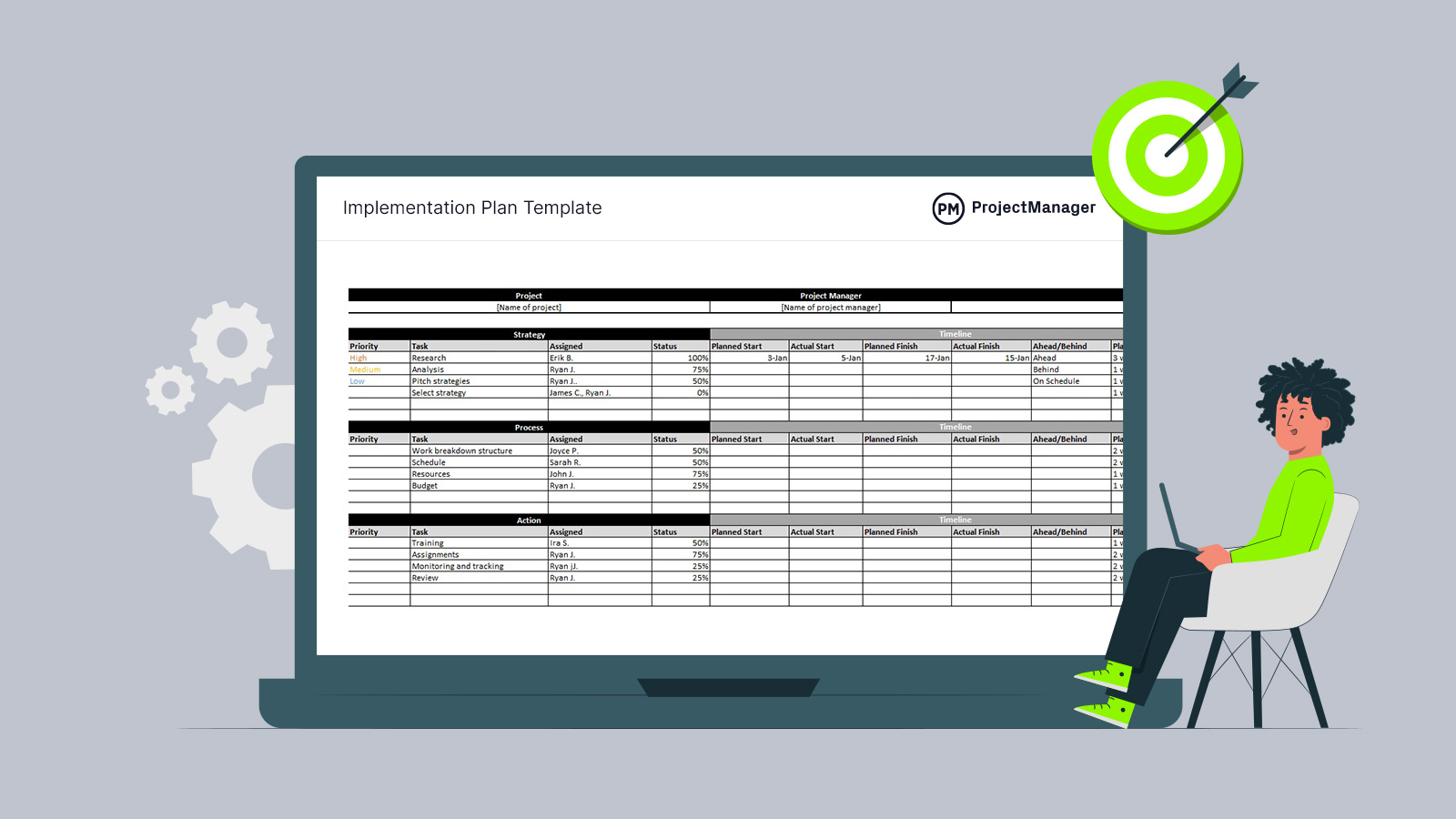
Get your free
Implementation Plan Template
Use this free Implementation Plan Template for Excel to manage your projects better.
Implementation Plan vs. Project Plan
A project plan is a comprehensive project management document that should describe everything about your project including the project schedule, project budget, scope management plan, risk management plan, stakeholder management plan and other important components. An implementation plan, on the other hand, is a simplified version of your project plan that includes only the information that’s needed by the team members who will actually participate in the project execution phase, such as their roles, responsibilities, daily tasks and deadlines.
Execute Implementation Plans Online with ProjectManager
Project management software like ProjectManager greatly simplifies the implementation planning process. Schedule and execute your implementation plan with our robust online Gantt charts.
- Set baselines, link dependencies and filter for the critical path
- Collaborate on multiple views like sheet, task list, kanban boards and calendars
- Track costs, resources and progress in real time with dashboards and reports. Try it for free
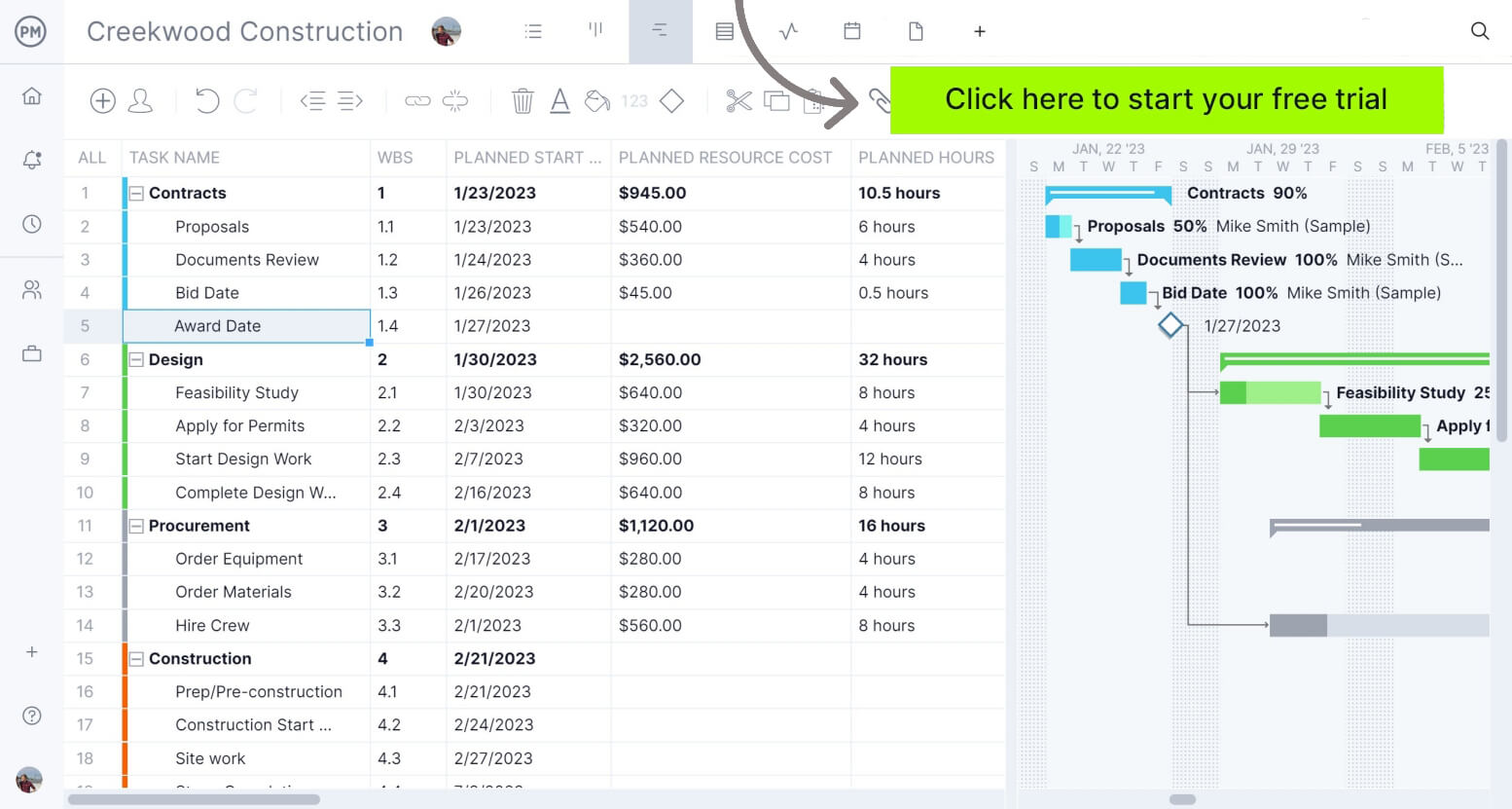
When Should an Implementation Plan Be Used?
An implementation plan is used when the project moves into the execution phase, but its development begins prior to that. In fact, the first seeds of a project implementation plan are planted in the initiation phase when the need for such a document is identified.
During the planning phase is when the implementation plan for the project is primarily developed. All the key components are defined and stakeholders are included in the process to ensure their input is incorporated. When the project is executed, the plan will be put to use in the project’s day-to-day operations: this includes the monitoring and controlling phase as it occurs parallel to execution. Even in closing a project, the plan is reviewed to evaluate the project’s success.
Why Is Implementation Planning Important?
There are a number of reasons why a project implementation plan is important. The fact that it’s a roadmap for the project team to follow as they execute is reason enough to stress its importance, but that’s only one. Here are some other reasons to use this plan in projects.
- Allows Project Teams to Estimate Costs Accurately: By identifying necessary resources, such as materials and personnel, the project manager is able to better forecast project costs. The plan also includes a detailed task breakdown, which allows for a granular analysis of costs. A well-defined timeline leads to more precise cost calculations, too.
- Helps Avoid Scope Creep: Scope creep is when a project’s scope grows beyond its original objects. The project plan for implementation helps to avoid this by setting clear objectives from the outset and ensuring all team members understand what is included in the project scope. This detailed scope definition allows everyone to know when that boundary is crossed.
- Facilitates the Project Scheduling Process: The plan helps with project scheduling by breaking down tasks, making it easier to identify what needs to be done and in what order. This leads to a more realistic timeline for the project. The implementation plan also takes into account dependencies and resource availability, which ensures the schedule runs smoothly and stays on track.
Key Steps In Project Implementation
Here are some of the key steps that you must oversee as a project manager during the project execution phase. Your project implementation plan should have the necessary components to help you achieve these steps.
1. Communicate Goals and Objectives
Once you’ve outlined the project goals and objectives, the next step is to ensure that the team understands them. For the project to succeed, there must be buy-in from the project team. A meeting is a good way to communicate this, though having project documents that they can refer to is also viable.
2. Define the Scope of Work
This critical step identifies project objectives, outlines goals and gathers requirements, including expectations and any constraints that might affect the project. This is when deliverables for the project are listed, boundaries of what’s in and out of scope are defined and a work breakdown structure is used to identify all tasks and subtasks. Resources are also identified, success criteria carted and ensuring that the scope is communicated clearly to the team.
3. Estimate Resource Requirements
Resource requirements are first identified in the scope of work and now those resources are further defined. This starts with a listing of all project tasks and then determining the resource types needed, such as human, material, equipment and financial. Availability of those resources is then checked and quantities forecasted. This will be reviewed with stakeholders.
4. Identify Potential Risks
Risks are unexpected events, but they can be managed proactively by establishing a risk management team and defining risk criteria. The project team should brainstorm on what risks could arise during the project, list these and categorize them in terms of their impact and probability of occurrence. At this point, the risks can be prioritized to allow teams to know how to respond to them.
5. Define Team Roles and Responsibilities
The project manager will define the roles and responsibilities and communicate them to the project team. They should understand what they’re expected to do and who they can reach out to with questions about their work, all of which leads to a smooth-running project.
6. Establish the Success Criteria for Deliverables
The project deliverables need to meet quality standards, and to do this there must be a success criteria for handing off these deliverables. You want to have something in place to determine if the deliverable is what it’s supposed to be. The measurement is called a success criteria and it applies to any deliverable, whether it’s tangible or intangible.
7. Schedule Work on a Project Timeline
All projects require a schedule, which at its most basic is a start date and an end date for your project. In between those two points, you’ll have phases and tasks, which also have start and finish dates. To manage these deadlines, use a project timeline to visually map everything in one place.
8. Monitor Cost, Time and Performance
To make sure that you’re keeping to your schedule and budget, you need to keep a close eye on the project during the execution phase. Some of the things you should monitor are your costs, time and performance. Costs refer to your budget, time refers to your schedule and performance impacts both as well as quality. By keeping track of these metrics, you can make adjustments to stay on schedule and on budget.
9. Report to Project Stakeholders
While the project manager is monitoring the project, the stakeholders, who have a vested interest in the project, are also going to want to stay informed. To manage their expectations and show them that the project is hitting all its milestones, you’ll want to have project reports, such as project status reports. These can then be presented to the stakeholders regularly to keep them updated.

Free Implementation Plan Template
Use this implementation plan template for Excel to define your strategy, scope, resource plan, timeline and more. It’s the ideal way to begin your implementation process. Download your template today.

What Are the Key Components of an Implementation Plan?
There’s no standard one-size-fits-all solution when it comes to creating your implementation plan. However, we’ve created an implementation plan outline for your projects. Here are its components.
- Project goals & objectives: The project goal is the ultimate goal of your project, while the objectives are the key milestones or achievements that must be completed to reach it.
- Success criteria: The project manager must reach an agreement with stakeholders to define the project success criteria.
- Project deliverables: Project deliverables are tangible or intangible outputs from project tasks.
- Scope statement: The scope statement briefly describes your project scope, which can be simply defined as the project work to be performed.
- Resource plan: Create a simple resource plan that outlines the human resources, equipment and materials needed for your project.
- Risk analysis: Use a risk assessment tool like a SWOT analysis or risk register. There are different tools with different levels of detail for your risk analysis.
- Implementation timeline: Any implementation plan needs a clear project timeline to be executed properly. You should use an advanced tool such as a Gantt chart to create one.
- Implementation plan milestones: You need to identify key milestones of your implementation plan so that you can easily keep track of its progress.
- Team roles & responsibilities: The implementation plan won’t execute itself. You’ll need to assign roles and responsibilities to your team members.
- Implementation plan metrics: You’ll need KPIs, OKRs or any other performance metrics you can use to control the progress of your implementation plan.
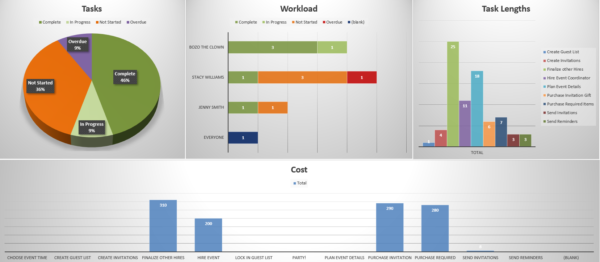
How to Write an Implementation Plan
Follow these steps to create an implementation plan for your project or business. You can also consider using project management software like ProjectManager to help you with the implementation process.
1. Review Your Project Plan
Start by identifying what you’ll need for the execution of your implementation plan:
- What teams need to be involved to achieve the strategic goals?
- How long will it take to make the strategic goals happen?
- What resources should be allocated?
By interviewing stakeholders, key partners, customers and team members, you can determine the most crucial assignments needed and prioritize them accordingly. It’s also at this stage that you should list out all the goals you’re looking to achieve to cross-embed the strategic plan with the implementation plan. Everything must tie back to that strategic plan in order for your implementation plan to work.
2. Map Out Assumptions and Risks
This acts as an extension to the research and discovery phase, but it’s also important to point out assumptions and risks in your implementation plan. This can include anything that might affect the execution of the implementation plan, such as paid time off or holidays you didn’t factor into your timeline, budget constraints, losing personnel, market instability or even tools that require repair before your implementation can commence.

3. Identify Task Owners
Each activity in your implementation plan must include a primary task owner or champion to be the owner of it. For tasks to be properly assigned, this champion will need to do the delegating. This means that they ensure that all systems are working as per usual, keep track of their teams’ productivity and more. Project planning software is practically essential for this aspect.
4. Define Project Tasks
Next, you need to finalize all the little activities to round out your plan. Start by asking yourself the following questions:
- What are the steps or milestones that make up the plan?
- What are the activities needed to complete each step?
- Who needs to be involved in the plan?
- What are the stakeholder requirements?
- What resources should be allocated?
- Are there any milestones we need to list?
- What are the risks involved based on the assumptions we notated?
- Are there any dependencies for any of the tasks?
Once all activities are outlined, all resources are listed and all stakeholders have approved (but no actions have been taken just yet), you can consider your implementation plan complete and ready for execution.
Implementation Plan Example
Implementation plans are used by companies across industries on a daily basis. Here’s a simple project implementation plan example we’ve created using ProjectManager to help you better understand how implementation plans work. Let’s imagine a software development team is creating a new app.
- Project goal: Create a new app
- Project objectives: All the project deliverables that must be achieved to reach that ultimate goal.
- Success criteria: The development team needs to communicate with the project stakeholders and agree upon success criteria.
- Scope statement: Here’s where the development team will document all the work needed to develop the app. That work is broken down into tasks, which are known as user stories in product and software development. Here, the team must also note all the exceptions, which means everything that won’t be done.
- Resource plan: In this case, the resources are all the professionals involved in the software development process, as well as any equipment needed by the team.
- Risk analysis: Using a risk register, the product manager can list all the potential risks that might affect the app development process.
- Timeline, milestones and metrics: Here’s an image of an implementation plan timeline we created using ProjectManager’s Gantt chart view. The diamond symbols represent the implementation plan milestones.
- Team roles & responsibilities: Similarly, we used a Gantt chart to assign implementation plan tasks to team members according to their roles and responsibilities.
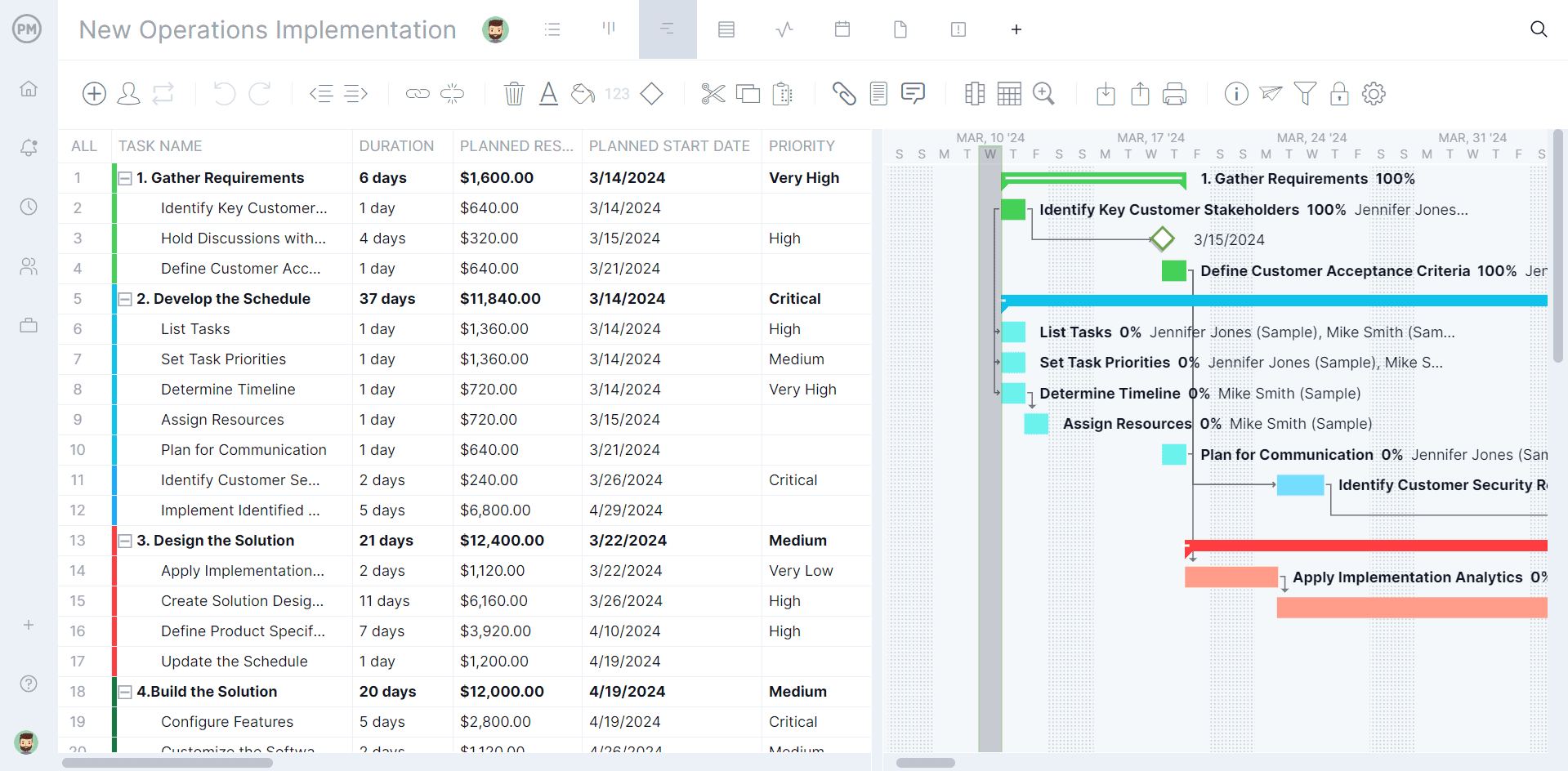
More Free Project Implementation Templates
There are many free project management templates for Excel and Word that can be downloaded for free from our site. These templates cover every aspect of managing a project across multiple industries. Here are just a few examples that can help with project implementation.
Gantt Chart Template
A Gantt chart is a classic project management scheduling tool that organizes tasks on a timeline to show the entire project. This free Gantt chart template for Excel helps project managers create a realistic timeline for their projects and, therefore, is crucial for the development of an implementation plan.
RACI Chart Template
Another aspect of the project implementation is defining the roles and responsibilities of the project team. This free RACI chart template for Excel helps everyone know what they’re responsible for by breaking roles down to responsible, accountable, consulted and informed.
Project Budget Template
An accurate budget must be determined at the very beginning of the project. Using this free project budget template for Excel will help project managers forecast costs realistically. It captures labor costs, consultant fees, raw materials, software licenses, trave and even telephone charges, office space and equipment rental, general administrative costs and insurance.
Benefits of an Implementation Plan for the Project Implementation Process
The implementation plan plays a large role in the success of your overall strategic plan. But more than that, communicating both your strategic plan and the implementation of it therein to your team members helps them feel as if they have a sense of ownership within the company’s long-term direction.
Increased Cooperation
An implementation plan that’s well communicated also helps to increase cooperation across all teams through all the steps of the implementation process. It’s easy to work in a silo—you know exactly what your daily process is and how to execute it. But reaching across the aisle and making sure your team is aligned on the project goals that you’re also trying to meet? That’s another story entirely. With an implementation plan in place, it helps to bridge the divide just a little easier.
Buy-In
Additionally, with an implementation plan that’s thoroughly researched and well-defined, you can ensure buy-in from stakeholders and key partners involved in the project. And no matter which milestone you’re at, you can continue to get that buy-in time and time again with proper documentation.
Guidance
At the end of the day, the biggest benefit of an implementation plan is that it makes it that much easier for the company to meet its long-term goals. When everyone across all teams knows exactly what you want to accomplish and how to do it, it’s easy to make it happen.
Implementation Plan FAQ
There’s more to know about implementation plans. It’s a big subject and we’ve tried to be thorough as possible, but if you have any further questions, hopefully we’ve answered them below.
What Is the Difference Between an Action Plan and an Implementation Plan?
The main difference between an action plan and an implementation plan is that an action plan focuses exclusively on describing work packages and tasks, while the implementation plan is more holistic and addresses other variables that affect the implementation process such as risks, resources and team roles & responsibilities.
What Is an Implementation Plan in Business?
A business implementation plan is the set of steps that a company follows to execute its strategic plan and achieve all the business goals that are described there.
What Is an Implementation Plan in Project Management?
Implementation plans have many uses in project management. They’re a planning tool that allows project managers to control smaller projects within their project plan. For example, they might need an implementation plan to execute risk mitigation actions, change requests or produce specific deliverables.
How to Make an Implementation Plan With ProjectManager
Creating and managing an implementation plan is a huge responsibility and one that requires diligence, patience and great organizational skills.
When it comes to a project implementation plan, there are many ways to make one that’s best suited for your team. With ProjectManager, you get access to both agile and waterfall planning so you can plan in sprints for large or small projects, track issues and collaborate easily. Try kanban boards for managing backlogs or for making workflows in departments.
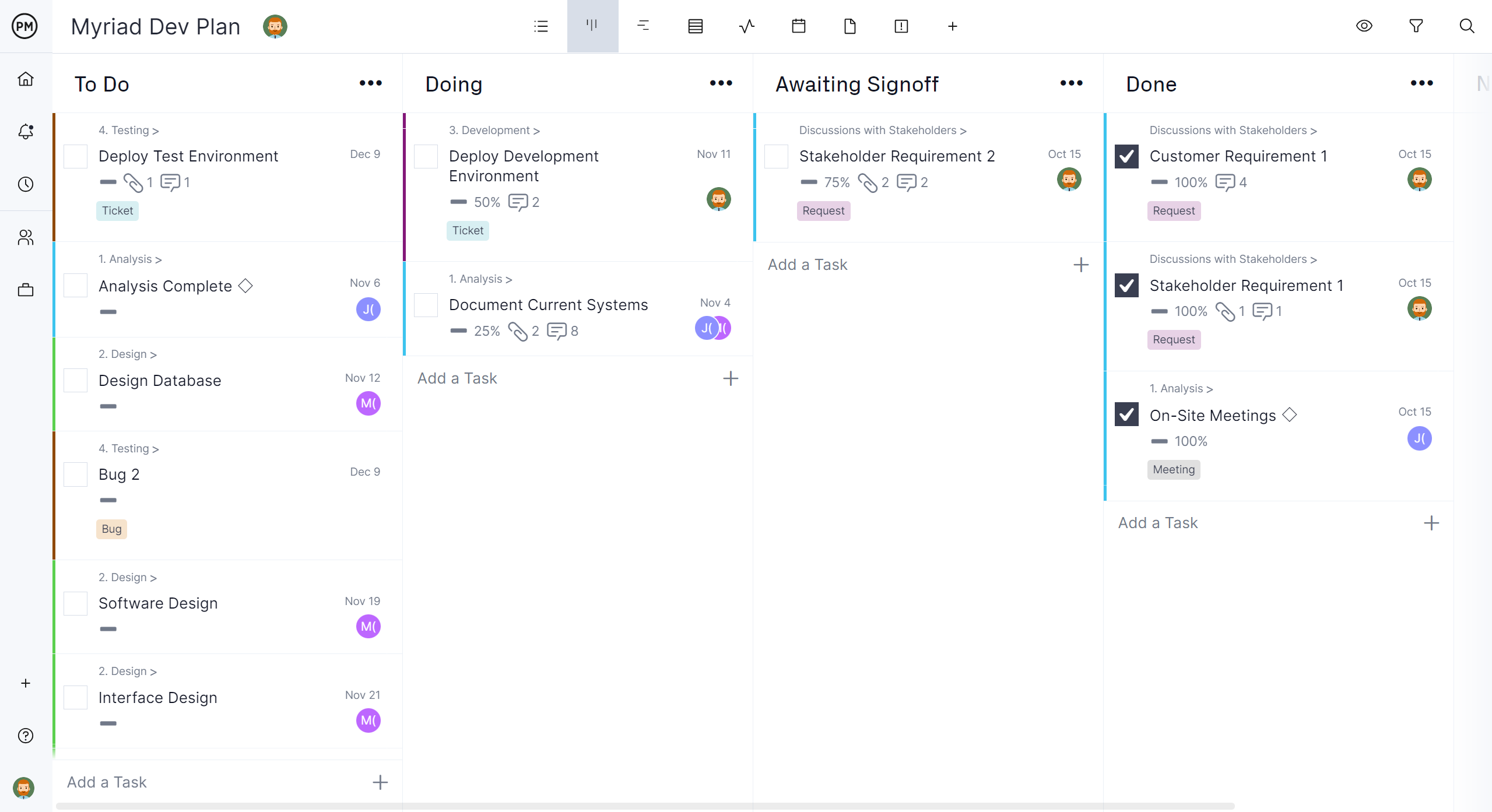
Switching up the activities after a milestone meeting with stakeholders? You can easily update your implementation plan with our software features. Add new tasks, set due dates, and track how far along your team is on their current activities.
Implementation plans are the backbone of an organization’s strategic overall plan. With ProjectManager, give your organization the project management software they need to gain insight into all resources needed, view activities on their lists and collaborate with ease. Sign up for our free 30-day trial today.

